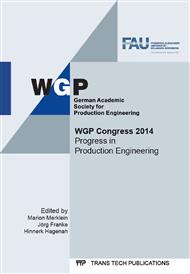p.237
p.245
p.253
p.261
p.269
p.277
p.285
p.293
p.301
Influence of Manufacturing Process on the Fatigue Strength of Gears
Abstract:
With cold forging processes it is possible to produce parts characterized by high strength, high dimensional accuracy and high surface quality. In order to optimize the forming process and to be able to use the advantages of cold forging specifically and combined, it is necessary to find correlations between manufacturing parameters on the one side, strength and other properties like hardness distribution and surface quality of the component on the other side. The research work covered in this paper focuses on the correlation of the components properties influenced by its manufacturing history and their fatigue strength. The used component is a gear produced by a lateral cold forging process. For the investigations an experimental setup has been designed. The aim for the design of the setup is to reproduce the real contact condition for the contact of two gears. To obtain different component properties the production process of the gear was varied by producing the parts by a milling operation. First of all, the components’ properties, for example hardness distribution, remaining residual stresses, orientation of fibers and surface quality, were determined. The components’ fatigue behavior was determined using a high frequency pulsator and evaluated in terms of finite life fatigue strength and fatigue endurance limit. These examinations were used to produce Woehler curves for the differently manufactured components with a certain statistical data analysis method.
Info:
Periodical:
Pages:
269-276
Citation:
Online since:
September 2014
Authors:
Keywords:
Price:
Сopyright:
© 2014 Trans Tech Publications Ltd. All Rights Reserved
Share:
Citation:


